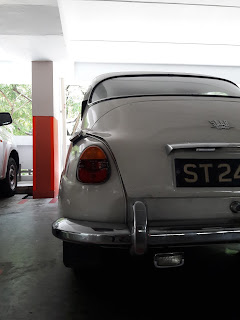Having featured the well-known Saab 900 previously, I hope that it has educated you on this car brand that seems to be stuck between being popular and obscure. However, surprises do keep coming, such as this 1967 Saab 96, which is possibly the oldest Saab car in Singapore!
The Saab 96 (internally known as Project 93C) was first introduced in 1960, as a replacement for the 93 and was the 3rd production car by Saab. It featured greater storage space and a larger rear window for better visibility. Some time in 1965, it underwent a facelift that featured a more intricate front end and a longer engine bay, in anticipation for a larger engine. A major facelift also happened in 1974, where the headlights became rectangular and the chrome bow was replaced with black plastic.
It was praised for its unique aerodynamic shape, giving little wind noise at high speeds and the adjustable back seats, allowing one to load more goods if necessary. The Saab 96 proved popular due to its durability and ease of maintenance, and was suitably equipped for the Nordic conditions such as heating mechanisms, large tyres and abundant ground clearance.
An unusual feature was the 'freewheel', where the transmission could run faster than the engine, providing an advantageous fuel consumption when going downhill for instance. As such, it proved popular at rally events, experiencing success throughout the 60s. It was equipped with a 841 cc Saab i3 engine, allowing it to reach a top speed of 127 km/h with an acceleration of 24.1 seconds [0-60 mph]. It was 4170 mm long and weighed 873 kg.
Production of the Saab 96 ended in 1980 with 547,221 units made. Currently, this is 1 of 2 units that are left in Singapore, where the other unit is a facelifted version with the rectangular lights. It was first introduced here in 1961 by Malayan Motors, where it had a retail price of $6,950 [approximately $30,000 in today's money]. I am inclined to think that few people would know what this odd-looking machine is, given how Saab is dying out here. It is also surprising that the owner has kept it it good condition, even sporting its original plate number! This unit seems to be driven once in a while and if you're lucky, you can perhaps see it on the road!







